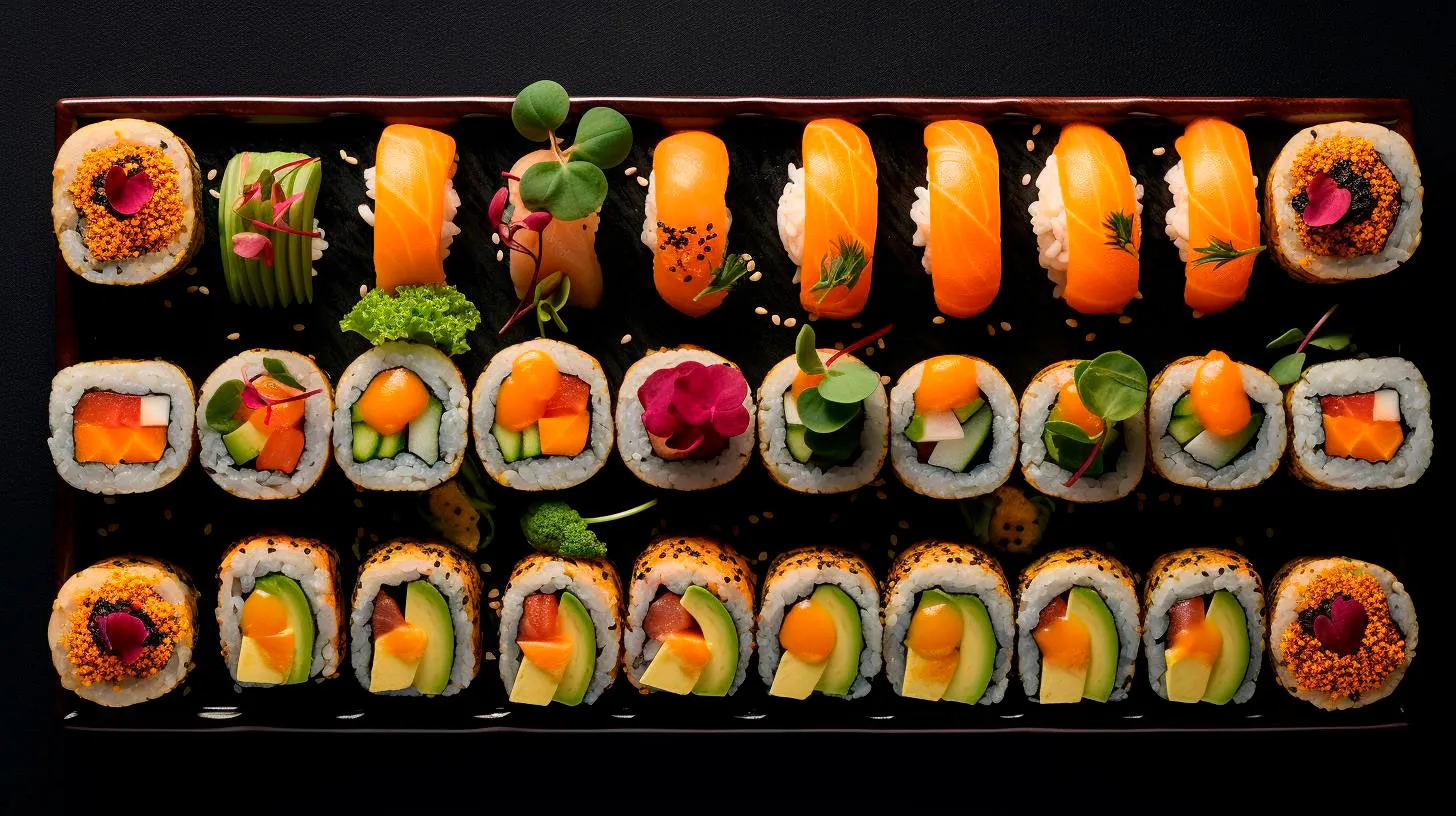The Evolution of Sushi: Japanese Authenticity vs Western Adaptations
This article delves into the evolution of sushi, exploring the clash between Japanese authenticity and Western adaptations. Join us on this gastronomic journey as we explore the different aspects of sushi and its cultural impact.
The Origins of Sushi
The history of sushi dates back to the 8th century in Japan. In its earliest form, sushi was created as a way to preserve fish by fermenting it with salt and rice. This traditional method, known as Narezushi, was developed as a technique to keep fish edible for long periods without refrigeration. Over time, sushi evolved, and new methods such as Nigiri (hand-pressed) sushi and Maki (rolled) sushi emerged.
Features and Advantages:
- Narezushi allowed for long-lasting preservation of fish.
- Nigiri sushi showcases the flavors and textures of the fish.
- Maki sushi offers a convenient way to enjoy various ingredients together.
The Rise of Sushi in the Western World
With globalization, sushi gained popularity in the Western world during the late 20th century. However, as it made its way into new markets, sushi underwent significant transformations to suit the local preferences. Western adaptations of sushi often prioritize convenience, taste, and presentation over traditional authenticity.
One of the most notable examples is the California Roll. Invented in Los Angeles in the 1960s, the California Roll substituted traditional seaweed wrap with avocado and replaced raw fish with cooked crab meat. It became a gateway for many Westerners to try sushi for the first time, as it eliminated the perceived raw fish barrier.
Features and Advantages:
- The California Roll made sushi more accessible to Western palates.
- Using cooked ingredients appealed to those who were apprehensive about raw fish.
- It introduced fusion flavors which expanded the possibilities of sushi.
The Clash of Cultures
The clash between Japanese authenticity and Western adaptations has sparked debate among sushi enthusiasts. Traditionalists argue that Westernized sushi dilutes the essence of Japanese culinary heritage and caters to the mass market, compromising quality and taste. On the other hand, proponents of Western adaptations believe that it allows for greater creativity and variety, catering to diverse palates.
However, it is important to note that not all Western adaptations undermine the authenticity of sushi. Many skilled sushi chefs around the world have successfully blended traditional Japanese techniques with local ingredients, creating unique and delicious fusion sushi rolls.
Key Takeaways:
- Sushi evolves to suit local palates and cultural preferences.
- There is an ongoing debate regarding the authenticity of Westernized adaptations.
- Fusion sushi offers a delightful combination of traditional and local flavors.
The Future of Sushi
As sushi continues to gain popularity, it is fascinating to witness how it adapts and evolves over time. Sushi fusion has become mainstream, with innovative ingredients and flavor combinations being introduced regularly. Additionally, sustainability has become a crucial aspect of the sushi industry, with an increased focus on responsible fishing practices and eco-friendly packaging.
With advancements in technology, we can expect sushi to further transform. Concepts like sushi-making robots and virtual reality dining experiences may revolutionize the way we enjoy sushi in the future. However, it is essential to strike a balance between innovation and preserving the rich cultural heritage associated with sushi.
Key Takeaways:
- Sushi fusion continues to push culinary boundaries.
- Sustainability is a growing concern in the sushi industry.
- Technology will play a significant role in shaping the future of sushi.
In conclusion, the evolution of sushi showcases the dynamic nature of culinary traditions. While Japanese authenticity remains the bedrock of sushi, Western adaptations have introduced new flavors, presentation styles, and accessibility to a wider audience. The clash between cultures adds an exciting dimension to the sushi experience and ensures its continued growth and popularity worldwide.
The Art of Sushi: A Culinary Journey Blending Traditional and Modern Techniques
In this article, we will take a deep dive into the artistry behind sushi, exploring the fusion of traditional and contemporary methods, and the key takeaways from this fascinating journey.
The Rich Tradition of Sushi
Sushi has its origins in Japan dating back to the 8th century. Initially, it was developed as a method for preserving fish by marinating it in fermented rice. Over time, sushi evolved as a staple in Japanese cuisine and gained popularity beyond its borders.
Here are some intriguing facts about the traditional aspect of sushi:
- Sushi rice, known as shari, holds a significant role in sushi preparation. The rice is seasoned with rice vinegar, sugar, and salt, which contributes to its characteristic taste.
- Nigiri sushi is a classic style of sushi where a piece of fish is placed on top of a small mound of seasoned rice. It exemplifies the simplicity and elegance of traditional sushi.
- Maki sushi, or sushi rolls, are another traditional form of sushi. These rolls consist of a variety of fillings, such as raw fish, vegetables, and even tempura, wrapped carefully in nori (seaweed) and rice.
Sushi chefs, known as itamae, undergo years of training to master the art of sushi making. They develop a deep understanding of the ingredients, knife skills, and presentation techniques to create a harmonious balance of flavors and textures.
Incorporating Modern Techniques
While preserving its traditional roots, sushi has also embraced modern techniques to cater to evolving tastes and preferences. This fusion of tradition and innovation has revitalized the sushi scene and expanded its global popularity.
Here are some contemporary elements that have shaped the sushi landscape:
- Fusion Sushi: Chefs have started to experiment with unconventional flavors by combining elements from different cuisines. Fusion sushi incorporates ingredients like avocado, cream cheese, and even spices like sriracha, resulting in unique and bold flavors.
- Sustainable Practices: With the increasing focus on sustainable sourcing, sushi restaurants have adopted responsible fishing practices and sustainable seafood options. This ensures the longevity of the ocean’s ecosystem while delivering guilt-free dining experiences.
- Artistic Presentation: Sushi is not just a treat for the taste buds; it is a visual delight as well. Modern sushi chefs push the boundaries of creativity, presenting their culinary creations as edible works of art. Intricate garnishes, vegetable sculptures, and colorful arrangements add a new dimension to the sushi experience.
These modern techniques have not only transformed the sushi industry but have also attracted a wider audience who may have been initially hesitant to try traditional sushi.
Key Takeaways from the Art of Sushi
The art of sushi offers several key takeaways that enhance both the culinary experience and our overall understanding of the Japanese culture:
- Attention to Detail: Sushi-making requires precision and attention to detail. From selecting the freshest ingredients to the meticulous arrangement of each roll, it highlights the importance of perfection in Japanese culinary practices.
- Harmony of Flavors: Sushi embodies the delicate balance of flavors, textures, and colors. It teaches us the value of creating harmony in our meals by skillfully combining various ingredients.
- Cultural Appreciation: Exploring sushi allows us to delve into the rich cultural heritage of Japan. By understanding the tradition and techniques behind sushi, we can fully appreciate the cultural significance it holds.
In conclusion, sushi is an art form that beautifully blends the traditional and modern aspects of Japanese cuisine. It is a testament to the skill and creativity of sushi chefs who continue to captivate our taste buds. The combination of ancient techniques and contemporary innovations offers a culinary journey that is both authentic and exciting. So, the next time you savor a piece of sushi, remember the rich tradition and artistic vision that went into creating this gastronomic marvel.
Exploring Global Fusion: Japanese and American Influences in Sushi
The Rise of Sushi in America
Sushi’s journey to the United States was not an easy one. Initially, many Americans were hesitant to try this unfamiliar cuisine. However, with the wave of globalization and cross-cultural exchange, sushi gradually gained popularity in America. According to a study conducted by Statista, the revenue generated by sushi restaurants in the United States reached approximately $3.9 billion in 2019.
Japanese-American Sushi Rolls: A Match Made in Heaven
The fusion of Japanese and American influences in sushi can be best observed in the creation of unique sushi rolls. Traditional Japanese sushi primarily consists of fish, rice, and seaweed. However, American sushi has embraced innovation and experimentation by incorporating a variety of additional ingredients and flavors. Some popular examples of Japanese-American sushi rolls include:
- California Roll: Made with avocado, crab meat, and cucumber, this roll was invented in Los Angeles during the 1960s and has become a classic American favorite.
- Spicy Tuna Roll: Combining the traditional Japanese ingredients of tuna and rice with a spicy kick, the spicy tuna roll has become a staple on sushi menus across the United States.
- Tempura Roll: This roll combines the traditional tempura technique from Japan with fresh vegetables or seafood, resulting in a crispy and flavorful creation.
Fusion Techniques and Flavors
The fusion of Japanese and American influences extends beyond just the ingredients used in sushi. It also encompasses the techniques and flavors employed in its preparation.
One notable technique that has gained popularity in fusion sushi is the use of sauces. Traditional Japanese sushi tends to be light on sauces, with soy sauce and wasabi being the primary condiments. However, American sushi has introduced a variety of flavorful sauces such as spicy mayo, eel sauce, and sweet chili sauce.
Furthermore, fusion sushi also incorporates a wide range of additional flavors, giving it a diverse taste profile. From the sweetness of mango to the tanginess of cream cheese, fusion sushi offers an explosion of flavors that caters to different palates.
The Advantages of Fusion Sushi
Fusion sushi offers a myriad of benefits that contribute to its popularity:
- Expanded Menu: Incorporating different ingredients and flavors expands the options available for sushi lovers, appealing to a broader range of tastes.
- Cultural Exchange: Fusion sushi encourages cross-cultural exchange, allowing individuals to experience the flavors and culinary techniques from both Japan and America.
- Global Appeal: The fusion of Japanese and American influences in sushi has made it accessible and appealing to people from various cultural backgrounds, contributing to its global popularity.
Key Takeaways
Exploring the fusion of Japanese and American influences in sushi reveals the immense impact cultural exchange can have on culinary practices. The combination of flavors, techniques, and ingredients from both cultures has brought a new level of excitement and diversity to this traditional Japanese cuisine.
As the popularity of sushi continues to rise globally, fusion sushi serves as a testament to the ever-evolving nature of gastronomy.
Sushi Trends From Tokyo to New York
1. Omakase: The Art of Trusting the Chef
Omakase, meaning “I leave it up to you,” is a dining experience where the chef curates a personalized menu based on the freshest ingredients of the day. This trend has gained popularity in both Tokyo and New York, offering an intimate and exclusive experience for sushi enthusiasts. Key takeaways include:
- Omakase allows you to trust the chef’s expertise and creativity.
- It offers an opportunity to try unique and seasonal flavors.
- This personalized experience often comes with a premium price tag.
2. Fusion Sushi: Combining Cultures
In recent years, the fusion of Japanese and other international cuisines has become a prominent trend in sushi. New York, being a melting pot of cultures, has played a significant role in popularizing fusion sushi. Key features of this trend include:
- Combining traditional Japanese techniques with flavors from different cuisines.
- Introducing unique ingredients and cooking styles to sushi rolls.
- Creating vibrant and innovative sushi combinations, appealing to diverse palates.
3. Sustainable Sourcing: A Conscious Choice
As environmental awareness grows, the need for sustainable sourcing in the food industry has become essential. Sushi restaurants in both Tokyo and New York are embracing this trend by sourcing seafood responsibly. Important points to note are:
- Using locally caught seafood to reduce carbon footprint.
- Supporting fisheries that prioritize ethical fishing practices.
- Using sustainable alternatives to overfished species, such as using tofu or vegetables as substitutes.
4. Sushi in Convenience Stores: Affordable and Accessible
While high-end sushi restaurants offer an exquisite dining experience, the concept of affordable and readily available sushi has gained popularity. In Tokyo, sushi can be found in convenience stores, allowing locals and tourists to grab a quick bite. Key advantages of this trend include:
- Affordable prices compared to upscale sushi establishments.
- Convenience stores offering sushi made with fresh ingredients.
- Access to a variety of sushi options anytime, anywhere.
5. Sushi Delivery: From Restaurant to Your Doorstep
In today’s fast-paced world, sushi delivery services have become increasingly popular. This trend has gained momentum in Tokyo and spread to New York, offering the convenience of enjoying sushi in the comfort of your own home. Key takeaways from this trend include:
- Quick and hassle-free access to sushi without leaving your house.
- Ensuring the quality and freshness of the sushi through efficient delivery systems.
- Availability of online platforms for easy ordering and tracking.
In Conclusion
Sushi trends continue to evolve, blending tradition with innovation and catering to the diverse tastes of people worldwide. From the intimate experience of omakase to fusion sushi creations, the sushi scene in both Tokyo and New York offers a plethora of options for sushi enthusiasts. Whether you prefer high-end dining or affordable convenience, there is a sushi trend to satisfy every palate.


